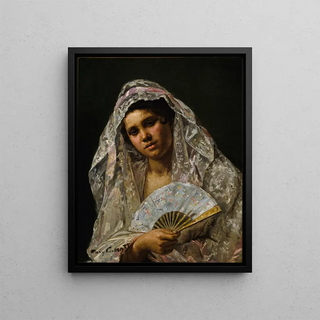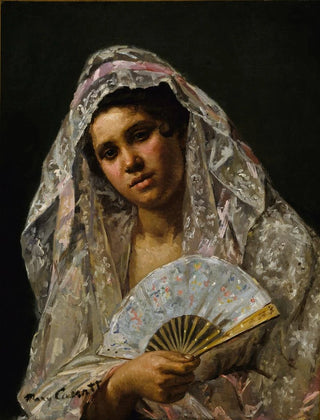Art print | Spanish dancer wearing a lace mantilla - Mary Cassatt Source: Reproduction | Danseuse espagnole portant une mantille en dentelle - Mary Cassatt


View from behind

Frame (optional)
Art print of the Spanish dancer wearing a lace mantilla - Mary Cassatt – Captivating introduction
In the fascinating universe of art, some works manage to capture the very essence of a culture while evoking deep emotions. "Spanish dancer wearing a lace mantilla" by Mary Cassatt is one of those creations that transcends the simple frame of the canvas to immerse us in a vibrant world of colors and movement. In this piece, the dancer, dressed in her delicate mantilla, embodies both grace and passion, inviting the viewer to feel the intensity of flamenco dance. Cassatt, renowned for her exploration of feminine themes, succeeds here in combining the beauty of women with the richness of a cultural tradition, offering a work that still resonates today.
Style and uniqueness of the work
Mary Cassatt's style is distinguished by her ability to blend impressionism with a unique sensitivity to women's lives. In "Spanish dancer wearing a lace mantilla," fluid and vibrant brushstrokes illustrate not only the movement of the dance but also the warm and festive atmosphere surrounding it. The composition is carefully balanced, highlighting the dancer while incorporating elements that evoke the Spanish scene, such as floral motifs and warm colors. The mantilla, in particular, is rendered with finesse that underscores Cassatt's skill in representing textures and nuances. This stylistic choice, which combines realism and impressionism, allows the viewer to feel the liveliness of the moment, making this work a true celebration of femininity and the art of dance.
The artist and her influence
Mary Cassatt, an emblematic figure of the Impressionist movement, managed to establish herself in an artistic environment dominated by men. Born in 1844 in Pennsylvania, she spent much of her life in France, where she formed connections with artists such as Edgar Degas and Édouard Manet. Cassatt often explored themes related to women's lives, mothers, and children, but she also opened up to other cultures, as evidenced by this work inspired by the

Matte finish

View from behind

Frame (optional)
Art print of the Spanish dancer wearing a lace mantilla - Mary Cassatt – Captivating introduction
In the fascinating universe of art, some works manage to capture the very essence of a culture while evoking deep emotions. "Spanish dancer wearing a lace mantilla" by Mary Cassatt is one of those creations that transcends the simple frame of the canvas to immerse us in a vibrant world of colors and movement. In this piece, the dancer, dressed in her delicate mantilla, embodies both grace and passion, inviting the viewer to feel the intensity of flamenco dance. Cassatt, renowned for her exploration of feminine themes, succeeds here in combining the beauty of women with the richness of a cultural tradition, offering a work that still resonates today.
Style and uniqueness of the work
Mary Cassatt's style is distinguished by her ability to blend impressionism with a unique sensitivity to women's lives. In "Spanish dancer wearing a lace mantilla," fluid and vibrant brushstrokes illustrate not only the movement of the dance but also the warm and festive atmosphere surrounding it. The composition is carefully balanced, highlighting the dancer while incorporating elements that evoke the Spanish scene, such as floral motifs and warm colors. The mantilla, in particular, is rendered with finesse that underscores Cassatt's skill in representing textures and nuances. This stylistic choice, which combines realism and impressionism, allows the viewer to feel the liveliness of the moment, making this work a true celebration of femininity and the art of dance.
The artist and her influence
Mary Cassatt, an emblematic figure of the Impressionist movement, managed to establish herself in an artistic environment dominated by men. Born in 1844 in Pennsylvania, she spent much of her life in France, where she formed connections with artists such as Edgar Degas and Édouard Manet. Cassatt often explored themes related to women's lives, mothers, and children, but she also opened up to other cultures, as evidenced by this work inspired by the






